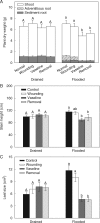Benefits of flooding-induced aquatic adventitious roots depend on the duration of submergence: linking plant performance to root functioning
- PMID: 28586427
- PMCID: PMC5737540
- DOI: 10.1093/aob/mcx049
Benefits of flooding-induced aquatic adventitious roots depend on the duration of submergence: linking plant performance to root functioning
Abstract
Background and aims: Temporal flooding is a common environmental stress for terrestrial plants. Aquatic adventitious roots (aquatic roots) are commonly formed in flooding-tolerant plant species and are generally assumed to be beneficial for plant growth by supporting water and nutrient uptake during partial flooding. However, the actual contribution of these roots to plant performance under flooding has hardly been quantified. As the investment into aquatic root development in terms of carbohydrates may be costly, these costs may - depending on the specific environmental conditions - offset the beneficial effects of aquatic roots. This study tested the hypothesis that the balance between potential costs and benefits depends on the duration of flooding, as the benefits are expected to outweigh the costs in long-term but not in short-term flooding.
Methods: The contribution of aquatic roots to plant performance was tested in Solanum dulcamara during 1-4 weeks of partial submergence and by experimentally manipulating root production. Nutrient uptake by aquatic roots, transpiration and photosynthesis were measured in plants differing in aquatic root development to assess the specific function of these roots.
Key results: As predicted, flooded plants benefited from the presence of aquatic roots. The results showed that this was probably due to the contribution of roots to resource uptake. However, these beneficial effects were only present in long-term but not in short-term flooding. This relationship could be explained by the correlation between nutrient uptake and the flooding duration-dependent size of the aquatic root system.
Conclusions: The results indicate that aquatic root formation is likely to be selected for in habitats characterized by long-term flooding. This study also revealed only limited costs associated with adventitious root formation, which may explain the maintenance of the ability to produce aquatic roots in habitats characterized by very rare or short flooding events.
Keywords: Adventitious root removal; Solanum dulcamara; benefit; cost; flooding duration; nutrient uptake; partial submergence; plasticity; root function; water uptake.
© The Author 2017. Published by Oxford University Press on behalf of the Annals of Botany Company. All rights reserved. For Permissions, please email: journals.permissions@oup.com
Figures






Similar articles
-
Life cycle stage and water depth affect flooding-induced adventitious root formation in the terrestrial species Solanum dulcamara.Ann Bot. 2015 Aug;116(2):279-90. doi: 10.1093/aob/mcv095. Epub 2015 Jun 22. Ann Bot. 2015. PMID: 26105188 Free PMC article.
-
Role of adventitious roots in water relations of tamarack (Larix laricina) seedlings exposed to flooding.BMC Plant Biol. 2012 Jun 27;12:99. doi: 10.1186/1471-2229-12-99. BMC Plant Biol. 2012. PMID: 22738296 Free PMC article.
-
Root signals and stomatal closure in relation to photosynthesis, chlorophyll a fluorescence and adventitious rooting of flooded tomato plants.Ann Bot. 2009 Jan;103(2):313-23. doi: 10.1093/aob/mcn208. Epub 2008 Nov 10. Ann Bot. 2009. PMID: 19001430 Free PMC article.
-
Root responses to flooding.Curr Opin Plant Biol. 2013 Jun;16(3):282-6. doi: 10.1016/j.pbi.2013.03.013. Epub 2013 Apr 19. Curr Opin Plant Biol. 2013. PMID: 23608517 Review.
-
The Physiology of Adventitious Roots.Plant Physiol. 2016 Feb;170(2):603-17. doi: 10.1104/pp.15.01360. Epub 2015 Dec 23. Plant Physiol. 2016. PMID: 26697895 Free PMC article. Review.
Cited by
-
Aspergillus nomiae and fumigatus Ameliorating the Hypoxic Stress Induced by Waterlogging through Ethylene Metabolism in Zea mays L.Microorganisms. 2023 Aug 7;11(8):2025. doi: 10.3390/microorganisms11082025. Microorganisms. 2023. PMID: 37630585 Free PMC article.
-
Effects of Combined Abiotic Stresses Related to Climate Change on Root Growth in Crops.Front Plant Sci. 2022 Jul 1;13:918537. doi: 10.3389/fpls.2022.918537. eCollection 2022. Front Plant Sci. 2022. PMID: 35845642 Free PMC article. Review.
-
Differential Growth Responses of Alternanthera philoxeroides as Affected by Submergence Depths.Front Plant Sci. 2022 Jun 2;13:883800. doi: 10.3389/fpls.2022.883800. eCollection 2022. Front Plant Sci. 2022. PMID: 35720589 Free PMC article.
-
Influence of Root System Characteristics on Black Spruce Seedling Responses to Limiting Conditions.Plants (Basel). 2019 Mar 19;8(3):70. doi: 10.3390/plants8030070. Plants (Basel). 2019. PMID: 30893840 Free PMC article.
-
Regulation of Root Traits for Internal Aeration and Tolerance to Soil Waterlogging-Flooding Stress.Plant Physiol. 2018 Feb;176(2):1118-1130. doi: 10.1104/pp.17.01157. Epub 2017 Nov 8. Plant Physiol. 2018. PMID: 29118247 Free PMC article. Review.
References
-
- Armstrong W. 1979. Aeration in higher plants In: Woolhouse HW, ed. Advances in botanical research. London, UK: Academic Press, 236–332.
-
- Armstrong W, Armstrong J.. 2014. Plant internal oxygen transport (diffusion and convection) and measuring and modelling oxygen gradients In: van Dongen JT, Licausi F, eds. Low-oxygen stress in plants: sensing and adaptive responses to hypoxia. Plant Cell Monographs, 21. Berlin: Springer, 267–298.
-
- Blom CWPM, Voesenek LACJ, Banga M, et al.1994. Physiological ecology of riverside species: adaptive responses of plants to submergence. Annals of Botany 74: 253–263.
MeSH terms
Substances
LinkOut - more resources
Full Text Sources
Other Literature Sources
Medical
Research Materials

